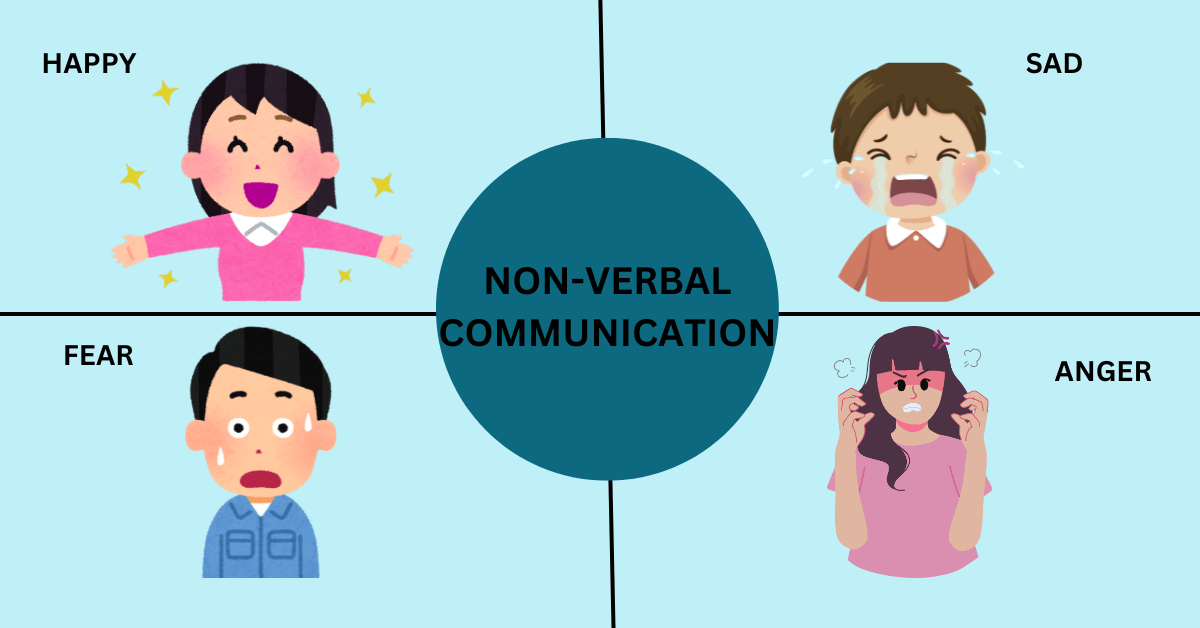Non-verbal communication is an essential aspect of effective communication, often conveying more meaning than words alone. In English, as in any other language, non-verbal cues such as body language, facial expressions, gestures, and eye contact play a pivotal role in interpreting and understanding messages. These elements can reinforce what is being said, indicate emotions, and provide feedback without the need for words. Understanding the importance of non-verbal communication in English can greatly enhance one’s ability to communicate effectively and build stronger relationships in both personal and professional contexts.
Understanding Non-Verbal Communication
Non-verbal communication refers to the transmission of messages or information without the use of words. It encompasses a wide range of behaviors and physical cues, including:
- Body Language: Posture, movements, and physical stance.
- Facial Expressions: Movements of the facial muscles that convey emotions.
- Gestures: Hand and arm movements that emphasize or illustrate spoken words.
- Eye Contact: The use of eye movements and gaze to communicate attention and interest.
- Proxemics: The use of personal space and distance in communication.
- Haptics: The use of touch in communication.
- Paralanguage: Vocal elements such as tone, pitch, and volume.
Each of these components plays a crucial role in the communication process, adding depth and meaning to verbal interactions.
The Role of Body Language in English Communication
Body language is a powerful form of non-verbal communication that can convey a wide range of emotions and intentions. In English communication, body language often complements verbal messages, helping to clarify meaning and express feelings that words alone may not fully capture.
Positive Body Language
Positive body language includes open gestures, relaxed posture, and appropriate eye contact, which can help build rapport and trust. Examples include:
- Open Gestures: Using open hand movements and avoiding crossed arms to appear approachable and engaged.
- Relaxed Posture: Standing or sitting with a straight but relaxed posture to convey confidence and attentiveness.
- Appropriate Eye Contact: Maintaining eye contact without staring to show interest and respect.
Negative Body Language
Negative body language, such as closed gestures, tense posture, and avoiding eye contact, can create barriers in communication and convey disinterest or discomfort. Examples include:
- Closed Gestures: Crossing arms or legs, which can indicate defensiveness or reluctance.
- Tense Posture: Stiffness or rigidity in posture, which may signal anxiety or hostility.
- Avoiding Eye Contact: Looking away or down, which can suggest dishonesty or lack of confidence.
Facial Expressions and Their Impact
Facial expressions are a universal form of non-verbal communication that can convey a wide range of emotions, from happiness and surprise to anger and sadness. In English communication, facial expressions play a key role in expressing emotions and reinforcing verbal messages.
Key Facial Expressions
- Smiling: Indicates friendliness, approval, and positivity. A genuine smile can help build rapport and create a positive atmosphere.
- Frowning: Shows disapproval, concern, or confusion. A furrowed brow can indicate that someone is thinking deeply or is displeased.
- Raised Eyebrows: Often signal surprise, curiosity, or skepticism. Raised eyebrows can prompt further explanation or clarification.
- Eye Movements: Rapid eye movements or blinking can indicate nervousness or discomfort, while steady eye contact can show confidence and engagement.
Cultural Considerations
While many facial expressions are universally recognized, cultural differences can influence their interpretation. For instance, in some cultures, direct eye contact is considered respectful, while in others, it may be seen as confrontational. Understanding these cultural nuances is essential for effective communication in diverse settings.
The Power of Gestures
Gestures are deliberate movements of the hands, arms, or other body parts that communicate specific messages. In English communication, gestures can enhance verbal messages, illustrate points, and convey enthusiasm or emphasis.
Common Gestures
- Thumbs Up: Indicates approval or agreement. It is a universally recognized positive gesture.
- Nodding: Shows agreement, understanding, or encouragement. Nodding can reinforce that you are listening and engaged.
- Pointing: Directs attention to specific objects or directions. However, pointing can be considered rude in some cultures, so it should be used with caution.
- Handshakes: A traditional gesture of greeting or agreement. The firmness and duration of a handshake can convey confidence and respect.
Cultural Variations
Gestures can vary significantly across cultures, and what is considered a positive gesture in one culture may have a different meaning in another. For example, the “OK” hand gesture (forming a circle with the thumb and forefinger) is positive in many Western cultures but can be offensive in some parts of the world. Being aware of these cultural differences is crucial for effective non-verbal communication.
Eye Contact and Its Significance
Eye contact is a fundamental aspect of non-verbal communication that conveys attention, interest, and respect. In English communication, eye contact can enhance the connection between speakers and listeners, making interactions more engaging and meaningful.
Positive Effects of Eye Contact
- Builds Trust: Maintaining eye contact can help build trust and rapport between individuals.
- Shows Engagement: It indicates that you are paying attention and are interested in the conversation.
- Facilitates Feedback: Eye contact allows for the exchange of non-verbal feedback, such as nodding or smiling, which can encourage the speaker.
Negative Effects of Poor Eye Contact
- Disinterest: Avoiding eye contact can suggest that you are not interested or engaged in the conversation.
- Dishonesty: Lack of eye contact can be perceived as a sign of dishonesty or evasiveness.
- Discomfort: Excessive or intense eye contact can make others feel uncomfortable or intimidated.
Cultural Differences
Similar to other forms of non-verbal communication, the interpretation of eye contact varies across cultures. In some cultures, prolonged eye contact is seen as respectful and attentive, while in others, it can be considered disrespectful or confrontational. Understanding these cultural variations is important for effective communication.
Proxemics: The Use of Space in Communication
Proxemics refers to the use of personal space and distance in communication. In English communication, the appropriate use of space can affect the comfort level and interaction dynamics between individuals.
Personal Space Zones
- Intimate Distance: Reserved for close relationships and private conversations (0 to 18 inches).
- Personal Distance: Used for conversations with friends and family (18 inches to 4 feet).
- Social Distance: Appropriate for interactions in social and professional settings (4 to 12 feet).
- Public Distance: Used for public speaking or addressing large groups (12 feet or more).
Impact on Communication
- Respecting Boundaries: Maintaining appropriate personal space shows respect for others’ comfort and boundaries.
- Building Comfort: Adjusting the distance based on the relationship and context can create a more comfortable and effective communication environment.
- Cultural Sensitivity: Different cultures have varying norms regarding personal space, and understanding these differences is crucial for effective cross-cultural communication.
Paralanguage: The Voice Beyond Words
Paralanguage refers to the vocal elements that accompany speech, such as tone, pitch, volume, and speed. These elements add nuance and emotion to verbal communication, significantly impacting how messages are received and interpreted.
Key Elements of Paralanguage
- Tone: The emotional quality of the voice that conveys feelings and attitudes.
- Pitch: The highness or lowness of the voice, which can indicate questions, statements, or emphasis.
- Volume: The loudness or softness of the voice, which can convey urgency, importance, or intimacy.
- Speed: The rate of speech, which can reflect excitement, nervousness, or confidence.
Enhancing Communication
- Matching Tone to Message: Ensure that your tone aligns with the content and emotion of your message.
- Adjusting Volume: Use appropriate volume levels to match the context and setting of the conversation.
- Controlling Speed: Speak at a moderate pace to ensure clarity and comprehension.
How EngVarta Helps Improve Non-Verbal Communication Skills
EngVarta is an innovative platform designed to help individuals improve their English communication skills through real-time practice and expert feedback. Here’s how EngVarta can support your journey to mastering non-verbal communication:
Real-Time Practice with Experts
EngVarta connects you with English experts who provide real-time practice sessions. These sessions allow you to practice non-verbal communication in a controlled environment, receive immediate feedback, and build confidence gradually.
- Personalized Sessions: EngVarta offers personalized practice sessions tailored to your specific needs and goals.
- Immediate Feedback: Receive constructive feedback on your body language, facial expressions, gestures, and overall delivery to identify areas for improvement.
Flexible and Convenient Learning
EngVarta App provides a flexible learning environment that fits your schedule, making it easier to practice regularly.
- Anytime, Anywhere: Practice non-verbal communication skills at your convenience, whether from home, work, or on the go.
- Consistent Practice: Regular practice is crucial for building confidence, and EngVarta’s flexible scheduling ensures you can maintain a consistent practice routine.
Safe and Supportive Environment
EngVarta offers a safe and supportive environment for practicing English communication without the fear of judgment.
- Judgment-Free Zone: Engage in practice sessions without the fear of being judged or criticized, allowing you to focus on improvement.
- Encouraging Experts: EngVarta’s experts are trained to provide positive reinforcement and constructive feedback, helping you build confidence in your non-verbal communication skills.
Conclusion
Non-verbal communication is a crucial aspect of effective communication in English, playing a significant role in conveying emotions, reinforcing verbal messages, and building rapport. By understanding and mastering the various components of non-verbal communication—body language, facial expressions, gestures, eye contact, proxemics, and paralanguage—you can enhance your overall communication skills and build stronger relationships.
EngVarta serves as a valuable tool in this journey, offering real-time practice, expert feedback, and a supportive environment to help you improve your non-verbal communication skills and gain confidence in English. By leveraging the resources and guidance provided by EngVarta, you can develop the ability to communicate more effectively and confidently in both personal and professional settings.


